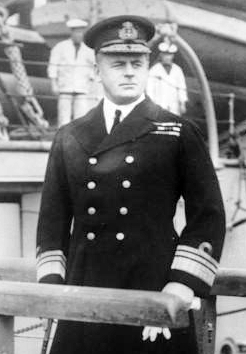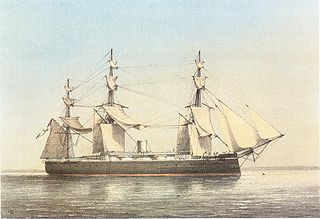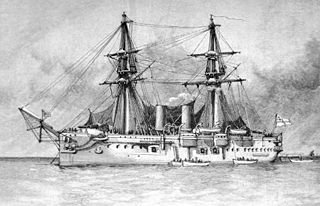
Rear Admiral Sir Horace Lambert Alexander Hood, was a Royal Navy admiral of the First World War, whose lengthy and distinguished service saw him engaged in operations around the world, frequently participating in land campaigns as part of a shore brigade. His early death at the Battle of Jutland in the destruction of his flagship HMS Invincible was met with mourning and accolades from across Britain.

HMS Invincible was a Royal Navy Audacious-class ironclad battleship. She was built at the Napier shipyard and completed in 1870. Completed just 10 years after HMS Warrior, she still carried sails as well as a steam engine.

Israel Harding, VC was a sailor in the Royal Navy and a recipient of the Victoria Cross, the highest award for gallantry in the face of the enemy that can be awarded to British and Commonwealth forces.

The Bombardment of Algiers was an attempt on 27 August 1816 by Britain and the Netherlands to end the slavery practices of Omar Agha, the Dey of Algiers. An Anglo-Dutch fleet under the command of Admiral Edward Pellew, 1st Viscount Exmouth bombarded ships and the harbour defences of Algiers.

Ville de Paris was a large three-decker French ship of the line that became famous as the flagship of De Grasse during the American Revolutionary War.

Charles Frederic Moberly Bell was a British journalist and newspaper editor. He was the managing director of The Times during the late 19th and early 20th centuries, where his innovations included founding the forerunners of the Times Literary Supplement and the Times Educational Supplement and co-sponsoring the Encyclopedia Britannica.

Admiral of the Fleet The Honourable Sir Hedworth Meux was a Royal Navy officer. As a junior officer he was present at the bombardment of Alexandria during the Anglo-Egyptian War.

HMS Penelope was a central-battery ironclad built for the Royal Navy in the late 1860s and was rated as an armoured corvette. She was designed for inshore work with a shallow draught, and this severely compromised her performance under sail. Completed in 1868, the ship spent the next year with the Channel Fleet before she was assigned to the First Reserve Squadron in 1869 and became the coast guard ship for Harwich until 1887. Penelope was mobilised as tensions with Russia rose during the Russo-Turkish War of 1877–78 and participated in the Bombardment of Alexandria during the Anglo-Egyptian War of 1882. The ship became a receiving ship in South Africa in 1888 and then a prison hulk in 1897. She was sold for scrap in 1912.

HMS Monarch was the first seagoing British warship to carry her guns in turrets, and the first British warship to carry guns of 12-inch (300 mm) calibre.

HMS Sultan was a broadside ironclad of the Royal Navy of the Victorian era, who carried her main armament in a central box battery. She was named for Sultan Abdulaziz of the Ottoman Empire, who was visiting England when she was laid down. Abdulaziz cultivated good relations with the Second French Empire and the British. In 1867 he was the first Ottoman sultan to visit Western Europe; his trip included a visit to England, where he was made a Knight of the Garter by Queen Victoria and shown a Royal Navy Fleet Review, with Isma'il Pasha of Egypt.

HMS Alexandra was a central battery ironclad of the Victorian Royal Navy, whose seagoing career was from 1877 to 1900. She spent much of her career as a flagship, and took part in operations to deter the Russian Empire's aggression against the Ottoman Empire in 1878 and the bombardment of Alexandria in 1882. She was affectionately known by her crew as Old Alex.

HMS Temeraire was an ironclad battleship of the Victorian Royal Navy which was unique in that she carried her main armament partly in the traditional broadside battery, and partly in barbettes on the upper deck.

HMS Superb was an ironclad battleship designed by Sir Edward Reed for the Ottoman Navy, and was built in Britain by Thames Ironworks under the name of Hamidieh. She had both engines and sails.

HMS Undaunted was one of seven Orlando-class armoured cruisers built for the Royal Navy in the mid-1880s.

HMS Formidable was a 98-gun second rate man-of-war serving the Royal Navy.

Robert Faulknor the younger (1763–1795) was an 18th-century Royal Navy officer, part of the Faulknor naval dynasty. He was court-martialled and died in an action off Guadeloupe in the eastern Caribbean Sea.
HMS Nonsuch was a 64-gun third rate ship of the line of the Royal Navy, built by Israel Pownoll and launched on 17 December 1774 at Plymouth. She was broken up in 1802.

The Bombardment of Alexandria in Egypt by the British Mediterranean Fleet took place on 11–13 July 1882.

Téméraire was a 74-gun ship of the line of the French Navy, ordered in December 1747 to a design by François Coulomb, and built at Toulon by his cousin, the constructor Pierre-Blaise Coulomb; she was launched on 24 December 1749. Her 74 guns comprised:
28 x 36-pounders on the lower deck
30 x 18-pounders on the upper deck
10 x 8-pounders on the quarterdeck
6 x 8-pounders on the forecastle.
La Bienvenue was a 20-gun French warship launched at Le Havre in 1788 that made several changes in ownership and name during military conflict with the British. She briefly became La Royalist in October 1792 before reverting to her original name in January the following year. She was serving as a prison ship at Martinique when she was captured by the British in 1794.



















